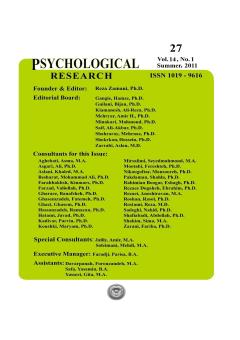Relationship between Supervisor's Support and Creativity While Considering the Mediating Role of Feelings of Energy at Work and Intrinsic Motivation
Subject Areas : psychologymohsen golparvar 1 , Fariba Padash 2
1 - Islamic Azad University, Khorasgan, Khorasgan. Isfehan
2 - Islamic Azad University, Khorasgan, khorasgsn, Isfehan
Keywords: Supervisor support, Feelings of energy, Intrinsic motivation, Creativity at work, Pygmalion effect,
Abstract :
Abstract: This research was administered with the aim of studying the relationship between supervisor support for innovation and creativity by considering the mediating role of intrinsic motivation and feelings of energy. Statistical population of the research consisted of Haier Factory employees in autumn of 2009, among which, 332 were selected using stratified random sampling to participate in the research. Research questionnaires included: Atwater and Carmeli's (2009), 8 item questionnaire for Assessment of Feelings of Energy at Work, Tierney et al's (1999), 9 item Creativity questionnaire, Tierney and Farmer's (2004), 11 item Supervisor's Support for Creativity Questionnaire, and Tierney et al's (1999), 5 item Intrinsic Structure Equation Modeling and Mediation Motivation Question-naire. Data were analyzed using Pearson's correlation coefficient and regression analysis. The results showed that there are positive significant relations between supervisor's support with intrinsic motivation, feelings of energy and creativity. The research model in which, feelings of energy at work and intrinsic motivation were mediators between supervisor support and employees' creativity at work through structure equation modeling and mediation regression analysis, has only been confirmed by adding an additional path between feelings of energy at work and intrinsic motivation. The findings of this research revealed a preliminary support for occurrence of the Pygmalion effect at work places.
شوماخر، آر. اي.، و لومكس، آر. جي. (1388). مقدمهاي بر مدلسازي معادله ساختاري. ترجمه وحيد قاسمي، چاپ اول. تهران: جامعهشناسان. (سال انتشار اثر به زبان اصلي 2004).
Amabile, T. M. (1988). A model of creativity and innovation in organizations. In B. M. Staw. & L. L. Cummings (Eds.), Research in organizational behavior, vol. 10 (pp.123-167). Greenwich, CT: JAI Press.
Atwater, L., & Carmeli, A. (2009). Leader-member exchange, feelings of energy, and involvement in creative work. The Leadership Quarterly, 20, 264-275.
Barron, R. M., & Kenny, D. A. (1986). The moderator-mediator variable distinction in social psychological research: Conceptual, strategic, and statistical consideration. Journal of Personality and Social Psychology, 51, 1173-1182.
Bass, B. M. (1985). Leadership and performance beyond expectation. New York: the Free Press.
Bass, B. M. (1990). From transactional to transformational leadership: Learning to share the vision. Organizational Dynamics, 18, 19-32.
Bass, B. M. (1995). Transformational leadership. Journal of Management Inquiry, 4, 293-298.
Eden, D. (1984). Self-fulfilling prophecy as a management tool: Harnessing Pygmalion. Academy of Management Review, 9, 64-73.
Eden, D. (1992). Leadership and expectations: Pygmalion effects and other self-fulfilling prophecies in organizations. Leadership Quarterly, 3, 271-305.
Ford, C. (1996). A theory of individual creative action in multiple social domains. Academy of Management Review, 21, 1112-1142.
Fredrickson, B. L. (1998). What good are positive emotions? Review of General Psychology, 2, 300-219.
Fredrickson, B.L. (2001). The role of positive emotions in positive psychology: The broaden and build theory of positive emotions. American Psychologist, 56, 218-226.
Gumusluoglu, L., & Ilsev, A. (2009). Transformational leadership, creativity, and organizational innovation. Journal of Business Research, 62, 461-473.
Isen, A.M. (2004). Some perspectives on positive feelings and emotions: Positive affect facilitates thinking and problem solving. In A.S.R. Manstead, N. Frijda & A. Fischer (Eds.), Feeling and emotions: The Amsterdam symposium (pp. 263- 281). Cambridge, NY: Cambridge University Press.
Madjar, N., Oldham, G. R., & Pratt, M. G. (2002). There's no place like home? The contributions of work and non-work creativity support to employee's creative performance. Academy of Management Journal, 45, 757-767.
Phillips, A. P., & Dipoye, R. L. (1989). Correlational tests of predictions from a process model of interview. Journal of Applied Psychology, 74, 41-52.
Redmond, M. R., Mumford, M. D., & Teach, R. (1993). Putting creativity to work: Effects of leader behavior on subordinate creativity. Organizational Behavior and Human Decision Processes, 55, 120-151.
Spreitzer, G., Sutcliffe, K., Dutton, J., Sonenshein, S., & Grant, A. M. (2005). A socially embedded model of thriving at work. Organizational Science, 16, 537-549.
Tierney, P., & Farmer, S. M. (2002). Creative self-efficacy: Its potential
antecedents and relationship to creative performance. Academy of Management Journal, 45, 1137-1148.
Tierney, P., & Farmer, S. M. (2004). The Pygmalion process and employee creativity. Journal of Management, 30, 413-432.
Tierney, P., Farmer, S. M., & Graen, G. B. (1999). An examination of leadership and employee creativity: The relevance of traits and relations. Personnel Psychology, 52, 591-620.
Woodman, R. W., Sawyer, J. E., & Griffin, R. W. (1993). Toward a theory of organizational creativity. Academy of Management Journal, 18, 293-321.


